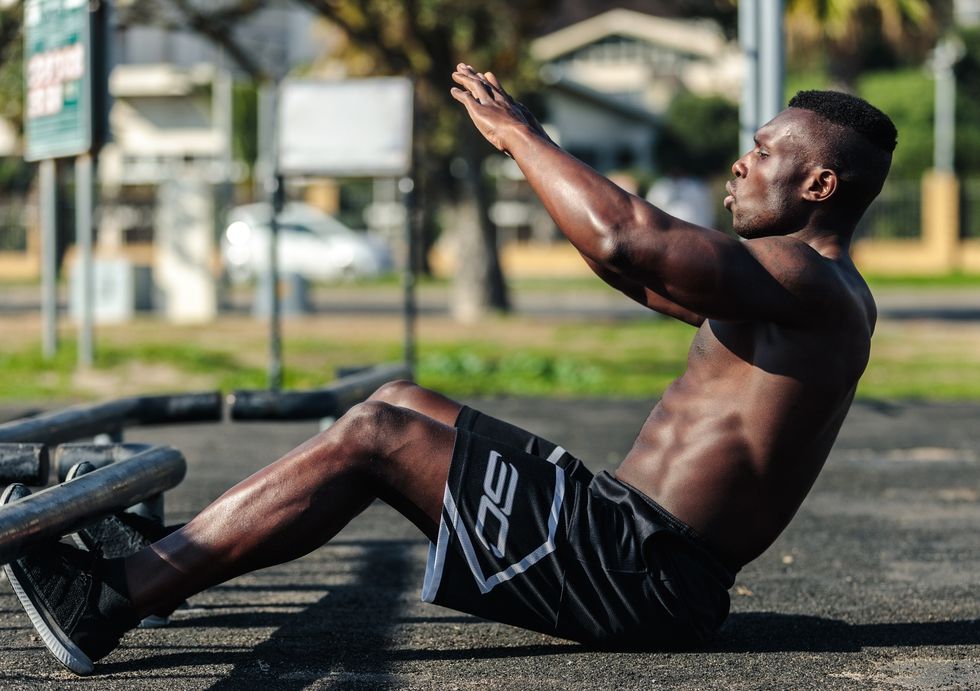YOU’VE ALMOST CERTAINLY heard the term ‘body fat percentage’ before, whether in conversation in the gym changing room, marketing fodder for fitness transformations, or even in a Men’s Health article. With a little bit of know-how, the measure can act not just as a motivator on your fitness journey, but better yet, a dependable marker of health. But that begs the question, what is a healthy body fat percentage?
‘When starting on a fitness journey, the odds of you actually sticking to it has been shown to be only 33 per cent,’ explains Josh Silverman, head of education at Third Space London. ‘Unlike BMI, this measurement takes into account your lean mass as well as total weight. Being in the healthy range will reduce your risk of developing diabetes, heart disease, metabolic syndrome and more.’
Let’s chew the fat about body fat.
Fun fact: due to it being so active in the body’s functioning, fat is technically an organ. Far from being something to fear or vilify, fat is actually essential for human life. There are different types – brown, white, subcutaneous, visceral – and each has its own function, for better or worse. Visceral fat and subcutaneous fat are the two we’re going to focus on here.
Visceral fat is stored around internal organs as a protective mechanism, explains Silverman. ‘It’s the first fat that is usually used for fuel when you go on an exercise regime,’ he says. ‘This is why you might see the scales go down by your body appears to look the same for the first few weeks.’ Visceral fat is the most dangerous kind, but thankfully, it’s also the easiest to lose.

The less harmful stuff, subcutaneous fat, is the type that prevents your abs popping. ‘It’s the one stored between our skin and muscles which give us that ‘fluffy’ look,’ explains Silverman. ‘It insulates the skin and acts as stored energy for times where the body doesn’t have food in its system.’ Which although evolutionarily important, is practically redundant in today’s landscape where food sources are abundant.
What is body fat percentage?
Put simply, your body fat percentage is a measure of the proportion of fat mass in your body. It is the total mass of fat, divided by total body mass, times by 100. If you weigh 100kg and have 10kg of fat, for instance, you’d have 10% body fat.
Knowing your body fat percentage can be a good measure of fitness and functionality, says Dr Steven Heymsfield, professor at Pennington Biomedical Research Centre. For men aged 20-39, a score of above 25 per cent is classed as obese, for gents aged 40-59, this cut off point is raised slightly to 28 per cent.
Although higher percentage can represent health risks, the goal should never be to reduce body fat as far as possible: we’re talking about gym-goers who strive to get their score as low as possible, aiming for that worrying point where ripped meets translucent. We’re certainly not suggesting you go that low. ‘Pushing your body fat percentage below five per cent is very risky,’ says Heymsfield. ‘There are reports of deaths at these levels.’
The Royal College of Nursing defines a healthy body fat range as 8-20 per cent for 20-39 year old men, rising to 11-22 per cent if you’re between 40 and 59. ‘The value often cited for healthy men with normal BMIs is 15 per cent,’ says Heymsfield.
Vascular, lean muscle is one thing, a shrink-wrapped human is another. So, what is a healthy body fat percentage? Nuffield health recommends for men:
- 20-39 years old 19% or less
- 40-59 years old 22% or less
- 60-79 year olds 25% or less
Whereas the American Council on Exercise (ACE) recommends for men:
- Essential fat: 2-5%
- Athletes: 6-13%
- Fitness: 14-17%
- Acceptable: 18-24%
- Obesity: >25%

How to measure body fat percentage
First you need to accurately measure what you’re working with. These days there are a wealth of different tools you can use to measure your body fat. Below, Silverman runs through your options, varying in reliability.
For the best results, take the tests first thing in the morning on an empty stomach, don’t drink water or participate in strenuous exercise beforehand – yes, including running for the bus – and re-test in the exact same conditions every three to four weeks.
DEXA Scanner
Known as the ‘gold standard’ due to its reliability and applicability, dual-energy X-ray absorptiometry (DEXA) is an X-ray machine designed to measure bone density that doubles up as a neat little body fat percentage scanner. You’ll find them at pop up clinics, but again they’re pretty expensive and will demand a couple of hours out of your day.
Hydrostatic weighing
Also known as hydrodensitometry or underwater weighing. You’re plunged into a big tank and scientists measure your fat levels using the Archimedes principle of fluid displacement. It’s expensive and time-consuming, but also considered one of the most accurate and reliable.
Calipers
Calipers are handheld devices used, quite literally, to pinch and measure your fat in different areas with a calculation that determines your body fat levels. The accuracy really depends how well-trained the person using them is – for this reason, they can be a little hit and miss.
Bioelectrical impedance analysis
You’ve probably spotted Bioelectrical Impedance Analysis scales in your local health club – they use electrical currents to measure your body fat (and often a wealth of other things, too: muscle mass, water, bone mass, etc). They’re your best bet for an affordable measurement of body fat percentage, though some makes are admittedly better than others. The main drawback, however, is that there is a higher degree of inaccuracy, especially when the electrical currents measure water percentage, which can be affected by dehydration.

What are the risks of high body fat?
According to the National Institute of Diabetes, Digestive and Kidney Diseases (NIH), the health risks of being overweight & obesity are:
- Type 2 diabetes
- High blood pressure
- Heart disease
- Stroke
- Sleep apnea
- Metabolic syndrome
- Fatty liver diseases
- Osteoarthritis
- Gallbladder diseases
- Cancer
- Kidney disease
What are the risks of low body fat?
Fat plays and important role in the body. It is our largest form of energy storage, helping us to survive during periods of low food supply. It also provides insulation and produces hormones that regulate metabolism and support our immune system. Whilst it’s important to have a healthy body fat percentage and high muscle mass, there are some symptoms associated with having very low body fat. According to an article published in Open Oregon Educational Resources:
- Osteoporosis and low bone mineral density
- Increased risk of infection, delayed wound healing, and greater post-surgical complications
- Cardiovascular disease, including stroke, heart attack, and coronary heart disease
- Some cancers, plus poorer response to treatment and survival rates after diagnosis
- Decreased semen quality

What is a realistic body fat percentage?
A healthy body fat percentage isn’t the same for every person – it will fluctuate depending on your height, age, genetics, as well a host of many other factors. As long as you’re within the recommended ranges, though, you needn’t worry. While incredibly important to be kept at healthy levels, regardless of your body fat percentage, it’s important to focus on:
- Balanced meal portions adequate for your energy needs and goals. You could adjust this using various methods such as calorie counting or mindful eating for weight loss, maintenance or gain. To work out your calorie goals for fat loss, use our guide here.
- Enough protein in your meals. For those with goals of getting leaner and gaining muscle, 2.2g of protein per kg of body mass is suitable. You can check out our guide on protein intake here.
- Adequate fibre intake from whole foods. Aiming for 30 grams of fibre per day is suitable. This can be obtained from fruit, vegetables, legumes and whole grains.
- Resistance training 2-5 times a week with adequate recovery. This will ensure you maintain and gain muscle mass which is vital in maintaining a healthy body fat percentage.
- 150 minutes a week of moderate cardiovascular exercise or 70 minutes of vigorous activity. This can be split up in a way suitable for your needs and fitness levels. It can even be completed doing low impact activities such as brisk walking or swimming.
This article originally appeared on Men’s Health UK.
Related:
How poor sleep affects your ability to lose body fat
This School Teacher Lost 13kg Of Body Fat By Joining A Fitness Challenge















